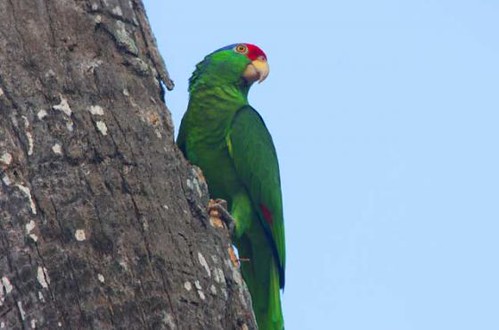 Green parakeet (Aratinga holochlora) Photo: Steve Sinclair
Green parakeet (Aratinga holochlora) Photo: Steve Sinclair
Wayne Bartholomew, executive director of Frontera Audubon in Weslaco, says visitors constantly ask him one question: "Where can I see the parrots and parakeets?
"He tells them, "I see them on a daily basis, mainly flying over the property, but they tend to roost in Gibson Park."
That's where he tells birders to find them in Weslaco, usually early in the morning or around dusk.
Bartholomew estimates Weslaco's wild parrot population at 200 to 300 birds. Most are red-crowned parrots, but he's also seen yellow-headed, red-lored and even a few lilac-crowned.
Parrots and parakeets are found throughout much of the Rio Grande Valley, a surprise to some who think of them as products of the Amazon rainforest.
"I began to notice them when I got involved in birding in 1996," noted Lee Zieger, president of the Rio Grande Delta Audubon Society.
"I was definitely shocked to see them. They are supposed to be a tropical bird and our weather is not that tropical," Zieger said.
 Red-crowned amazon (Amazona viridigenalis) Photo: Steve Sinclair
Red-crowned amazon (Amazona viridigenalis) Photo: Steve Sinclair
He estimates there are as many as 500 red-crowned parrots and several thousand green parakeets in the Valley.
Tony Knopp is a professor emeritus of history at the University of Texas at Brownsville and Texas Southmost College and enjoys viewing parrots and parakeets.
"For a long time I didn't know we had them here," he noted. "When I moved here from St. Paul (Minn.), I had no knowledge of parrots and parakeets in the Valley.
"This is something kind of exciting: having birds that we really identify with the tropics here in the Valley," Knopp said.
"I give tours of Fort Brown and historic downtown Brownsville. I don't put parrots and parakeets on my tour list, but always hope to run into them as an added treat," he said.
UTB-TSC is considered one of the premium places to see parrots and parakeets, particularly along Elizabeth Street on the southern edge of the campus where the birds nest in dead palm trees.
 Red-crowned amazon (Amazona viridigenalis) Photo: Steve Sinclair
Red-crowned amazon (Amazona viridigenalis) Photo: Steve Sinclair
But Knopp also frequently sees them at the U.S. Customs and Border Protection office at nearby Gateway International Bridge.
"They often stop and settle down there and then when they start moving again, it's almost a blur," he said.
Tim Brush, a biology professor at the University of Texas-Pan American, had been a birder for four decades and is the author of "Nesting Birds of the Tropical Frontier." He's been a resident of the Valley since 1991.
"Probably during my first year here I became aware of the parrots and parakeets," he recalled. "It probably did surprise me because you usually think of them being farther south.
"I think it's great they're here and a lot of my students are surprised to find out they're here," Brush noted.
Although early accounts of the Valley mention parrots and parakeets, there's always been a debate on whether the birds are here naturally.
"It's hard to tell," Brush said. "Both species (red-crowned parrots and green parakeets) occur in Tamaulipas.
"Red-crowned parrots were smuggled into the United States in the ‘70s and ‘80s and possibly some we see today could be descendants of the escaped birds or they could have come here on their own," he said.
"As for the green parakeets, there was a lot less smuggling because they were not as desirable as pets. My suspicion is that they came here on their own," he said.
Zeiger believes the parrots and parakeets, at least most of them, found their way to the Valley on their own.
"I think they're here naturally or they wouldn't be staying," he said.
Zeiger said the parrots and parakeets prefer to nest in palm trees, which are plentiful in the Valley.
"Woodpeckers initiate the holes and then parakeets move in and enlarge them," he said. "After that, the red-crowned parrots move and then the owls move in."
Zieger said the birds prefer city living.
"They seem to have adapted to life down here quite well. Urban areas are usually where you will find them," he said. "For example, they're not at Sabal Palm Audubon Center, but they're found three or four miles away at UTB."
Knapp, Zieger, Brush and Bartholomew each believe the Valley parrot and parakeet population is at worst holding its own.
"The Valley population is probably increasing," Bartholomew noted.